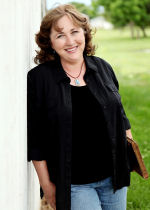|
 “Do
you know any Amish people?” my agent asked, during a phone call
discussing my nonexistent career back in 2009. “Do
you know any Amish people?” my agent asked, during a phone call
discussing my nonexistent career back in 2009.
“Two Amish men are building a
barn in back of my house right now, does that count?”
“It sure does! I’ve been
thinking . . . your name is Miller. You live in Ohio. If you can write
an Amish book, I have an editor who might buy it.”
At that point, I had been
writing, submitting, pitching, and entering writing contests for over
ten years. If she’d suggested I write a story about teenage vampire
turtles from Mars, I would have done it.
But,the reality was, apart from
a few pleasantries, I had never talked with an Amish person. The only
thing I knew was that they dressed funny, didn’t drive cars, and had no
electricity.
Fortunately, one of those Amish
carpenters—new to the area―invited us to his home to meet his wife. She
and I talked in depth, and I was surprised at how much we had in
common.
God opened doors, and I was
blessed with more Amish friends. I stayed in their homes, ate with
them, and did chores with them. I often wished I had known these people
earlier in my life. I would have done many things differently.
For one thing, physical
wellness is part of their lifestyle. Planted among my blueberry bushes
now are several elderberry bushes an Amish friend gave me. She
explained that elderberries are wonderful for coughs and colds. Another
friend tucked a jar of B&W (burns and wounds) ointment into my
purse—an Amish product they swear by.
Every Amish woman I met had a
store of wisdom about keeping a family healthy. One showed me her
baking center, which included a fifty-pound sack of wheat berries, a
battery-operated grinder, and a dough kneader. She said the whole
family had better digestion once she stopped using white flour.
A seventy-three-year-old mother
of twelve grown children told me that their family had been blessed
with uncommonly good health—part of which she attributed to her
husband’s self-training in reflexology (massaging certain pressure
points in the feet) and massaged their children’s feet when they were
not feeling well.
Whether or not reflexology
works, I don’t know, but a father ministering to his children in such a
loving and tender fashion had to have contributed greatly to their
feelings of well-being.
I noticed that they maintain a
steady pace while working. The carpenters who built our barn would stop
about every two hours for a few minutes to eat a small snack, drink
some water, and then go back to work. They never seemed to hurry, but
at the end of each day, they had achieved an enormous amount of work.
They are not against using
traditional medicine: however, when a terminal illness is diagnosed,
many will choose to die naturally rather than submit to heroic medical
measures. Their attitude is that if their goal in life is to get to
heaven, why bankrupt their family by clinging to this earth a few more
weeks? This might seem harsh to an outsider, but it appears to give
them a measure of peace.
Peace
is a big deal. I’m sure there are exceptions, but the homes of the
Amish I’ve visited have a serenity that I don’t sense in most non-Amish
homes. Several factors:
1) No decorative clutter―plain and simple is the standard
2) No background noise pollution like the hum of refrigeration,
computers, or other electric devices
3) No television
4) No electronic toys
5) No ringing telephones
6) No children fighting to draw Mom or Dad’s attention away from the
computer or TV
|
They
enjoy the security of being
part of a larger community. No Amish home is an island. When I visit my
Amish friends, more often than not other family members arrive bearing
dishes of food. We often eat, talk, and laugh late into the night.
Friendship, conversation, and hospitality is an art form to the Amish.
At one time I felt sorry for
the women because they had to wear the same type of outfit day after
day. Now I envy them: no makeup, no obsession with hairstyles, one
pattern that can be made into a dress in an evening, and a limited
choice of colors and materials. Instead of being restrictive, the
“uniform” saves both time and money.
 Although their
education ends
at eighth grade, they are grounded well enough in the basics that they
can make it through life and possess life skills, learned by working
beside skilled relatives, to make a living. Although their
education ends
at eighth grade, they are grounded well enough in the basics that they
can make it through life and possess life skills, learned by working
beside skilled relatives, to make a living.
This desire to work hard is
highly valued and is trained into their children from about the age of
two. A mother will hand a two-year-old toddler a small grocery sack to
carry into the house and will praise him for being a “good worker.”
When the Amish first began to
purchase farms in our impoverished pocket of Appalachia, I wondered how
they would make a living. Upholstery shops, bakeries, tin roof
supplies, woodstove dealerships, produce stands, carpentry, furniture
building, and myriad home business cropped up almost overnight. I was
amazed. These people could make a living anywhere—and they frequently
managed it while staying home with their families.
From what I’ve seen, they don’t
ever truly retire except in extreme old age or illness. One hearty,
elderly farmer I know, after selling his farm to a son-in-law for
“retirement” income, taught himself leather craft and now has a
flourishing business. The grandmother is deeply involved in canning and
gardening with her grown daughters. These grandparents live in a daadi
haus (“grandfather house”) attached to the main farmhouse and
are part of their children and grandchildren’s daily lives.
With the exception of God,
family and extended family are everything to the Amish. Children are
secure knowing they will be taken care of—even if something happens to
their parents. An Amish child going into foster care is, as far as I
know, unknown.
They are not evangelistic. They
rarely talk about their faith with outsiders unless directly asked. One
Amish businessman told me that a life lived with integrity and faith is
more effective in furthering the cause of Christ than many words.
In spite of not being
evangelistic, Old Order Amish is one of the fastest growing religions
in the world. Their numbers are doubling approximately every twenty
years, mainly because they tend to have large families and they retain
85 to 90 percent of their youth. Their church services aren’t exciting.
They don’t use instruments or even sing in harmony, which they consider
prideful. Their hymnal was written approximately 500 years ago. Their
ministers are untrained. And yet—with no church buildings or
comfortable pews―they have amazing retention.
So what is my takeaway?
Deep gratitude that I could
experience this fascinating culture; a proven example that a Christian
life honestly lived has a more powerful impact on the souls around us
than the latest evangelistic gimmick; a determination to continue
writing until I am too old or infirm to see the keyboard; and most of
all, a stronger determination to create an oasis of peace within my own
home and family.

|